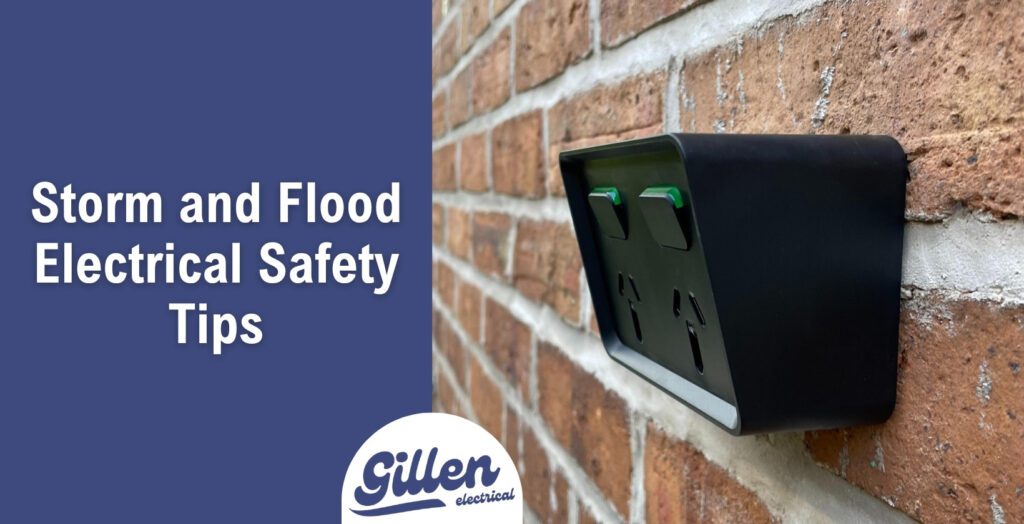You should unplug electronics before storms, avoid power during floods, know what to do if sockets get wet, test RCDs, check for water damage, protect outdoor gear, and keep an emergency kit ready. These habits reduce the risk of shock, fire, or system failure when wild weather strikes.
Any experienced commercial or industrial electrician will recommend installing a surge protection device in the switchboard, particularly if you live in a storm-prone area. A surge protection device diverts excess voltage safely to earth during a spike and protects every appliance in the home. These devices cost between $150–$250 to install and give peace of mind during weather events.
Our blog will discuss 6 important storm and flood electrical safety tips you need to follow before, during, and after a weather event.
6 Electrical Safety Tips During Storms and Floods
Here are the 6 electrical safety tips to follow during a storm or flood:
1. Unplug Devices Before Storms
Unplug sensitive electronics like routers, TVs, sound systems, gaming consoles, and computers before storms hit. These items are vulnerable to even small voltage surges.
Do this well before the storm arrives, not while it’s overhead. Waiting too long can expose you to shock if lightning strikes nearby.
For better long-term protection, install a surge protection device in your switchboard. It adds a barrier between your circuits and any spike from the grid or nearby lightning. Safety switches vs circuit breakers is another useful comparison worth knowing when reviewing your board setup.
2. Avoid Power During Floods
If floodwater enters your property, avoid all contact with power outlets and appliances. Electricity and water are a deadly combination, especially when currents ground through standing water.
Shut off the power at the main switchboard if it is still safe and dry to do so. If the board is submerged or wet, do not touch it — wait for a licensed electrician.
What To Do If Water Reaches Sockets
Do not touch wet sockets — turn off the circuit from the board first. Water inside outlets can trigger arcing or shock without warning.
Keep the area clear and wait for a licensed electrician to assess the damage. It’s not safe to test or reset the circuit on your own.
If you notice buzzing, crackling or discolouration, these are signs the wiring may already be damaged. The board should stay off until a full inspection confirms it’s safe to restore power.
3. Test RCDs After Weather Events
After a storm or flood, push the test button on your RCDs. This confirms they still trip correctly when a fault is simulated.
If the device fails to trip or reset properly, call a licensed electrician immediately. This indicates internal wear or water damage that has compromised safety.
Knowing what to do during electrical emergency events like these prevents bigger problems later. A working RCD may be the only thing preventing electrocution after a storm.
4. Inspect For Water Damage
Look for rust, bubbling paint, or water marks around power points, ceilings, and electrical panels. These signs suggest water has entered cavities behind the wall.
Any signs of water exposure mean the system needs checking before reuse. Damaged insulation or terminals can spark long after surfaces dry out.
Pay special attention to ceiling roses, outdoor lights and meter boxes. These spots tend to gather moisture but often go unchecked after bad weather.
Signs Of Moisture To Look Out For
Check for condensation on outlets, swollen wall plates, rusted conduit, or peeling finishes. These are common in laundry rooms, basements, or outdoor kitchens.
Musty smells or damp plaster near fittings also suggest that water has entered. These subtle clues often show up before visible mould or structural damage.
Don’t rely on a visual check alone — if in doubt, ask for thermal imaging or a moisture test. These inspections pick up trapped water inside walls or switchboards.
5. Secure Outdoor Equipment
Disconnect and cover external appliances like pool pumps, outdoor fridges, or lighting before heavy weather. Most of these units aren’t rated for water exposure or storm debris.
If not weather-sealed, these units become high-risk zones. Powerboards, exposed leads or corroded housings can trigger faults when switched back on.
Use protective enclosures or relocate vulnerable gear indoors. Prevention is far cheaper than post-storm replacement.
How To Waterproof Products For Fittings
Use IP-rated socket covers and enclosures for all outdoor GPOs and lights. The higher the IP rating, the better the resistance to water and dust.
Apply weatherproof sealant around cable entries and ensure gaskets are intact. Any gaps can allow moisture in and lead to long-term damage.
For best results, use UV-rated materials that won’t crack or shrink in summer heat. Combine that with proper installation to keep moisture out year-round.
6. Prepare an Emergency Kit
Your emergency kit should include rubber gloves, a torch, first aid items, spare batteries, and emergency numbers. These items help keep you safe until help arrives.
Keep the emergency kit in a dry container near the switchboard or your home’s safe zone. Replace anything that’s used or expired at the start of every storm season.

